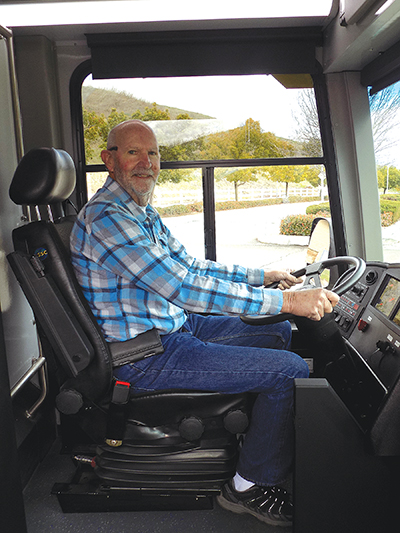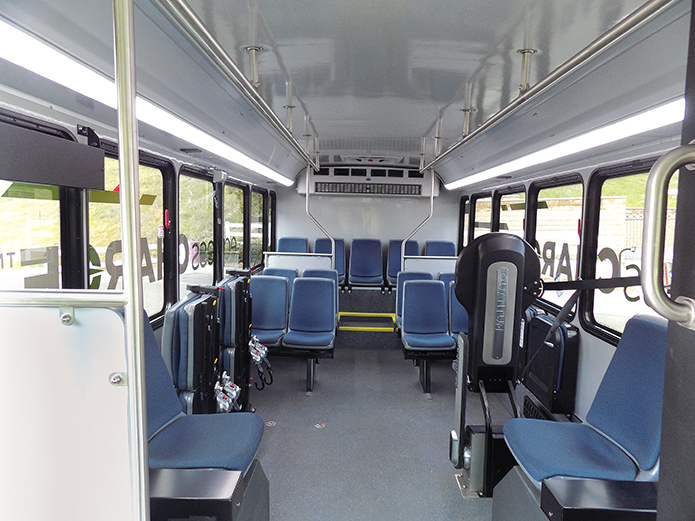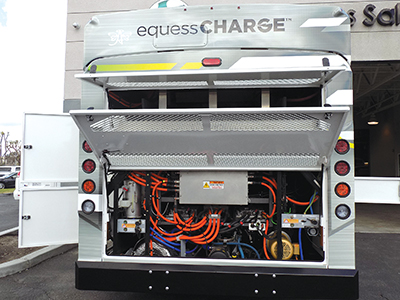
Photos by Patricia Knight
ARBOC Specialty Vehicles launched the Equess CHARGE in February, marking the first all-electric offering in the manufacturer’s vehicle lineup. The Equess CHARGE prototype is complete, and ARBOC anticipates full distribution in Q4 of 2021. Creative Bus Sales will exclusively distribute the vehicle in the United States, with Canadian distribution handled by Dynamic Specialty Vehicles, Crestline Coach, and Creative Carriage.
The vehicle – available in 30- and 35-foot models – was developed in conjunction with the New Flyer New Product Development team. The Equess CHARGE is modeled after the proven Equess shuttle/transit bus platform – but this zero-emissions model is powered by XALT energy storage systems, SIEMENS electric motor and New Flyer’s charging infrastructure.

Equal Access – and Enhanced Sustainability – for All
The stepless vehicle, like its Equess counterpart, features a 1:6 ramp slope extending from a 39-inch entrance door – exceeding ADA requirements and providing enhanced accessibility over a traditional bus design. The single-piece ramp was purpose-built for the Equess CHARGE, ARBOC said.
The vehicle’s SIEMENS ELFA3 direct drive motor is stored in a rear compartment, along with a portion of the energy storage system. The remaining energy storage system, including four to five battery strings, and battery thermal management system are roof-mounted.
The drive system, identical to the New Flyer all-electric platform, is charged via the depot charger’s CCS Type 1 plug. Agencies will be able to achieve a full charge of the vehicle within four hours, depending on charger.
The Equess CHARGE was designed, ARBOC said, as an all-purpose city transit bus. Airport circulator routes are also an ideal application for the vehicle. When proper charging infrastructure and maintenance are in place, the vehicle sports a very competitive price point against similar all-electric vehicle in the market.
The 30-foot model of the Equess CHARGE seats up to 25 passengers and accommodates up to four wheelchair positions. The 35-foot model can seat up to 33 passengers with six wheelchairs. Both models are available with single door or optional two-door designs.
The Equess CHARGE standard build features an electrical system by Parker Vansco, a roof-mounted HVAC system, and disc brakes by ZF.
The Equess CHARGE’s range is approximately 230 miles between charges, depending on driving environment and behavior. ARBOC is confident in the vehicle’s proven ability, as there are already over 1,900 New Flyer buses on the road today equipped with the same all-electric system.
ARBOC said that the New Flyer’s New Product Development and Infrastructure teams were instrumental in developing the Equess CHARGE, and so were the world-class facilities at New Flyer’s Vehicle Innovation Center (VIC).
Routing programs and other tools from the VIC allow ARBOC to plug agency-specific routes into a simulator, then provide agencies with exact range specifications based on terrain. Given the variable nature of electric vehicle ranges – which are affected by terrain, temperature, weather, and driving style – this level of accuracy is a valuable asset for ARBOC when projecting ranges for its customers.

Technology Options
As with all the vehicles in its lineup, ARBOC offers advanced safety systems on the Equess CHARGE as available as optional upgrades.
Technology provided by Rear View Safety (RVS), a Safe Feet company, includes the popular ARBOC-exclusive collision avoidance system, consisting of the RVS Eagle Drive 360° System combined with Eagle Drive ADAS (Advanced Driver-Assistance Systems). Utilizing cameras positioned around the bus, the system stitches together a composition 360° image of the vehicle and its surroundings. In-monitor collision avoidance signals allow the driver to focus on the single screen for both functions. The RVS-128 Advanced Blind Spot Sensor System features two waterproof sensors and an 82-foot detection area.
The optional RVS-335 iVue Driver Fatigue System uses an intelligent camera to detect drowsiness in the eyes of a driver. It detects bloodshot eyes and drooping eyelids, even with darkened sunglasses. In the event of drowsiness, the system sounds an audible alarm to alert the driver and simultaneously notifies dispatch.
 Test Driving the Equess CHARGE
Test Driving the Equess CHARGE
BUSRide visited the ARBOC team at exclusive-distributor Creative Bus Sales’ location in Chino, California. The Equess CHARGE prototype is currently touring dealerships for demos across America, with Chino as the first stop.
Ron Zirges, director of facilities and maintenance for Victor Valley Transit Authority (VVTA) in Hesperia, California, was the test driver of the Equess CHARGE on this Road Test. VVTA was the first agency in San Bernardino County to adopt all-electric vehicles, leading the pack now with 70 electric vehicles from New Flyer in its fleet. With his expertise in electric bus operation and maintenance, Zirges was an ideal person to test drive and review the Equess CHARGE.
Zirges comes from a background originally rooted in automotive maintenance. After receiving his ASE certification as a master technician, Zirges worked on cars and light trucks for almost 30 years. After receiving a call from nearby Riverside Transit Agency, he entered the world of buses as a maintenance manager.
He has since worked as a consultant for 12 different transit agencies around the country, as well as a maintenance manager for several other California agencies. He joined VVTA almost 10 years ago.
Zirges drove the 30-foot prototype Equess CHARGE on a route beginning in the Creative Bus Sales lot in Chino.
He initially put the vehicle through its paces, testing turning radius and braking. The 30-foot model can turn within 30 feet, and similarly the 35-foot model will turn within 35 feet. Zirges commented that the Equess CHARGE had a very tight turn compared to his experience with other buses of similar size.
The drive then made its way to the nearby Chino Valley Freeway, where Zirges could test the CHARGE’s highway pickup. The vehicle will not likely see many highways in its standard applications, but the test-drive served as a good measure of the vehicle’s power.
Cruising northwest on the highway toward the nearby Chino Hills community, Zirges commented on the vehicle’s pickup and regenerative braking.
“It picks up pretty well on the highway,” he said. “The regen braking is pretty aggressive, but smooth.”
 The regenerative braking feature can be tuned to Aggressive, Medium, or Mild, depending on terrain and operator preference. When used effectively, ARBOC said, the Equess CHARGE regenerative braking can significantly reduce brake usage – and in turn reduce brake wear and maintenance costs. ARBOC added that acceleration and regenerative braking are tunable at the factory, allowing agencies to specify preferences or requirements.
The regenerative braking feature can be tuned to Aggressive, Medium, or Mild, depending on terrain and operator preference. When used effectively, ARBOC said, the Equess CHARGE regenerative braking can significantly reduce brake usage – and in turn reduce brake wear and maintenance costs. ARBOC added that acceleration and regenerative braking are tunable at the factory, allowing agencies to specify preferences or requirements.
Turning off an exit to Chino Hills, Zirges pulled the Equess CHARGE down winding roads, curving through the hilly landscape and further testing the vehicle’s braking, turning, and start-stop capabilities.
The prototype vehicle which Zirges drove is equipped with a state-of-the-art (programmable) driver interface. Cycling through the display, he was able to view battery power, health, the status of the Kidde fire suppression system, and relative humidity. The Equess CHARGE also includes New Flyer’s ‘Connect 360’ telematics and analytics reporting. The collected data harnesses the potential for additional range capability through improved driving and vehicle performance.
In the rare event of a lithium-ion fire, this display screen can make a critical difference in detecting a fire early and quickly evacuating the bus.
The vehicle also came with a large driver barrier as an optional upgrade, aimed at protecting drivers from bacteria or even assault.
“The driver door barrier has become very popular lately, especially with COVID and attacks against drivers,” he said. “Many agencies are getting them.”
As he pulled the Equess CHARGE back into the Creative Bus Sales lot, Zirges said that the bus would work great on some of the local routes in the area.
“The buses I have now at VVTA will go a little over 200 miles on one charge – and this Equess CHARGE will probably go 230,” he said. “It has almost the same size of battery pack as our buses, so that is a great prospect for similar routes.”
Zirges also praised the vehicle’s clearance, comparing its height to other buses with similar specifications.
“The bus height is a great element of this vehicle,” he said. “It’s only 120 inches tall from the ground up. Many buses like this – powered by electricity or CNG – are around 140 inches. That gives it great clearance. It would work well in an airport application, where clearances can be really restrictive.”
Preparing for Production and Deployment
ARBOC plans to simplify the complex process of transitioning entire fleets to battery-electric sustainability – starting with infrastructure. In this area, ARBOC will work closely with NFI Group and New Flyer’s Infrastructure Solutions Group to support their customers in the undertaking of infrastructure projects. This can include design, budgeting, planning, and procurements, as well as other critical areas of concern for electric bus deployments.
With that critical network of support, the company said it is confident that the Equess CHARGE and its proven, reliable system will find many suitable applications in agencies across America when it begins distributing vehicles later this year.
